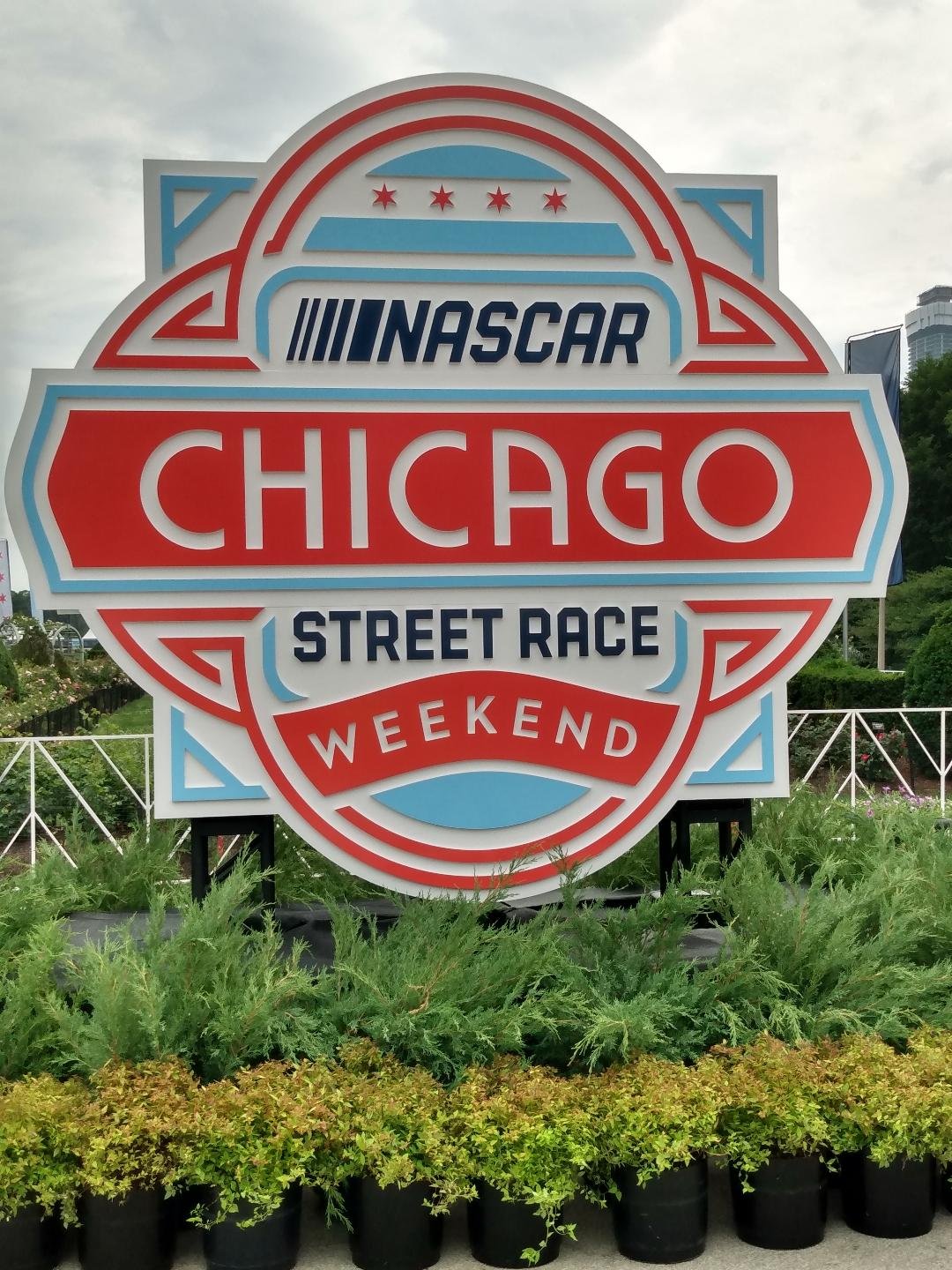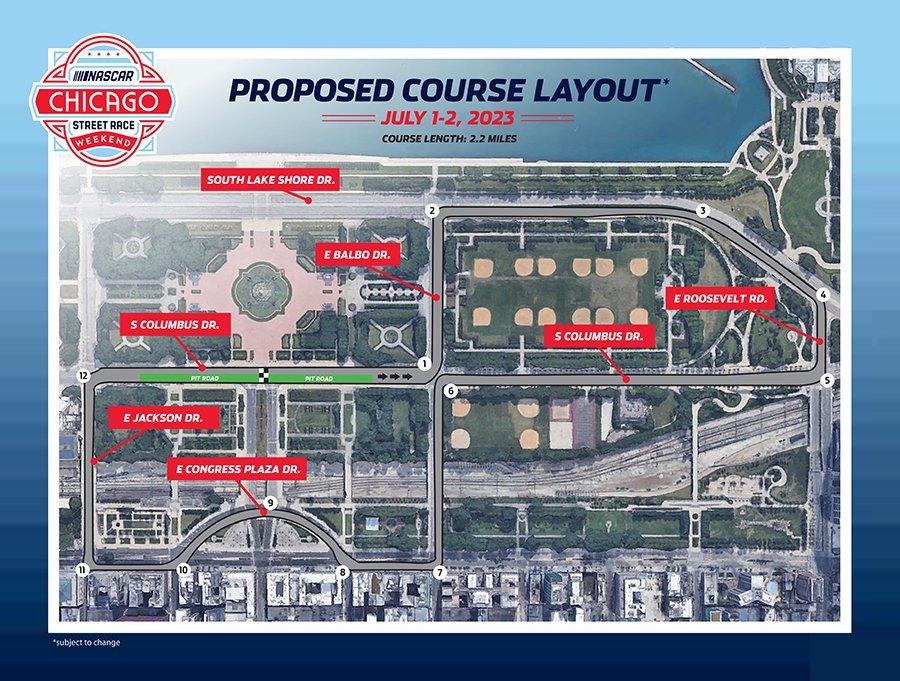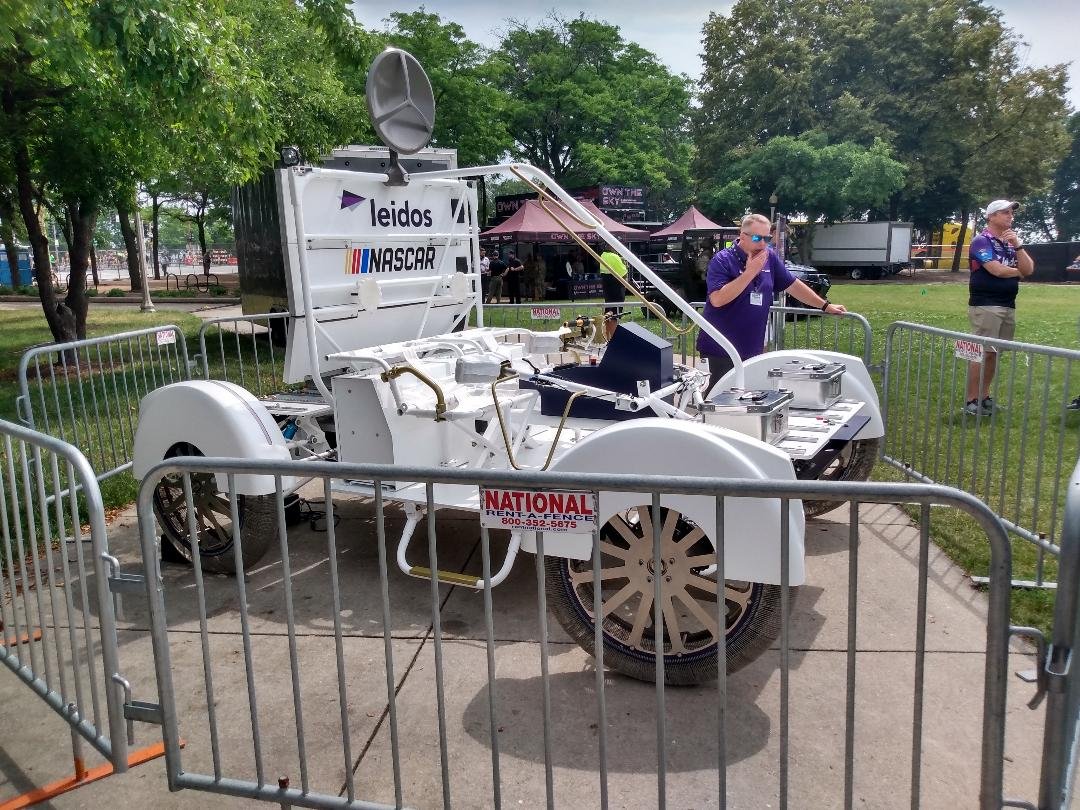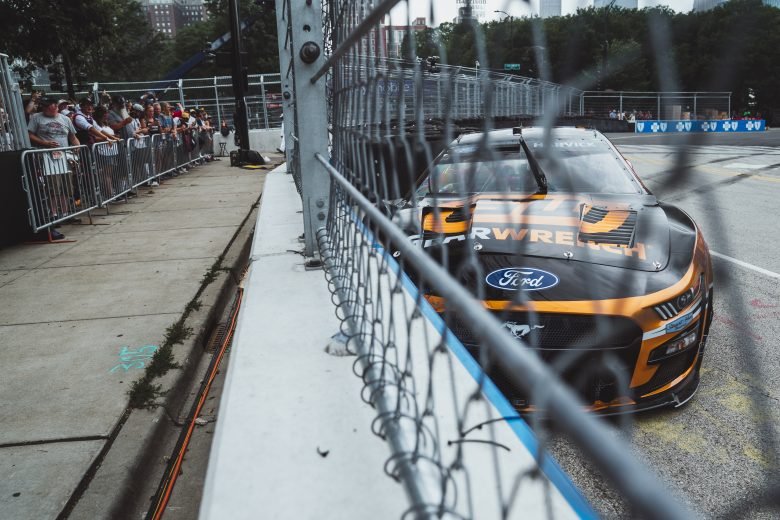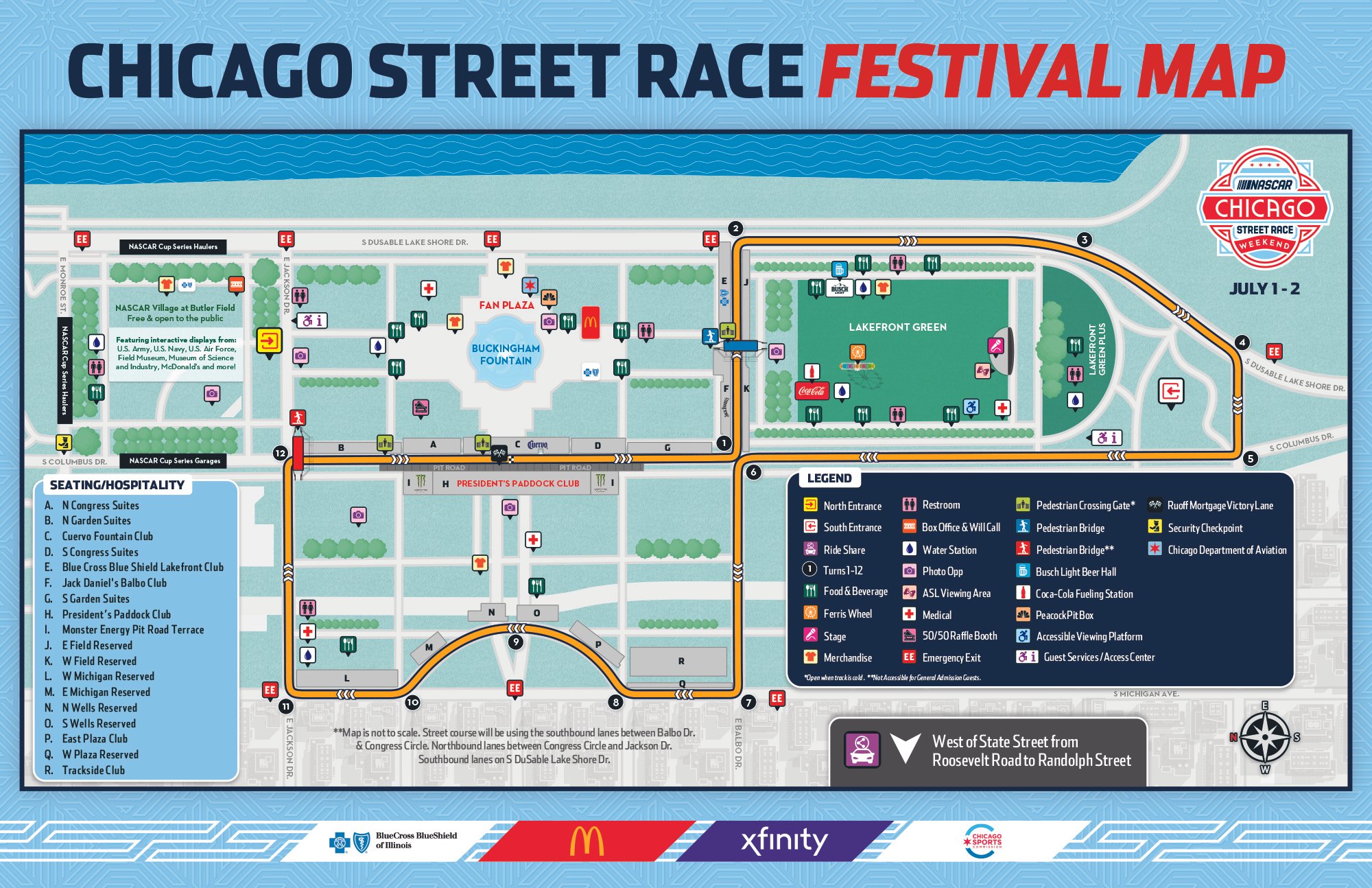NASCAR’s First Street Race
by Larry E. Nazimek
NASCAR is celebrating its 75th Anniversary, and they have been having races that differ from the usual race in a large paved oval track. Among them have been races on dirt and on a quarter mile track inside of the Los Angeles Memorial Coliseum. On July 1 and 2, they ran their very first street race in Chicago.
Chicago was the location for the first auto race, held on Thanksgiving, 1895. It was an out and back to the nearby suburb of Evanston, shortened from the plan for Milwaukee (considered too far for the cars of that age) and Waukegan (shortened on account of the snow). 6 cars started, but winner J. Frank Duryea, with an average speed of 7 mph., was only one of two drivers to finish. The second driver was so cold and tired that he passed out before the finish line, forcing an umpire assigned to his car to coax it across the finish line. If that wasn’t enough, Chicago’s first 500 mile race was held on June 26, 1915, at the Speedway Park in Maywood.
A NASCAR race on Chicago’s lakefront is not unprecedented, either. In 1956, NASCAR legend Fireball Roberts won a Grand National Series (forerunner to today’s NASCAR Cup Series) race inside of Soldier Field. The surface of Soldier Field was a lot larger than what you see on today’s football games. Back then, “stock” cars were the type of cars that that people could buy at a dealership, far different from today’s stock cars, that are racing machines and are not street legal.
The Saturday Loop 121 Xfinity Race was scheduled for 55 laps of the 2.2 mile course, for 121 miles, while the Sunday Grant Park 220 Cup Series ran for 100 laps. The name “loop” originally came from a cable car line that circled the city’s central business district in the 1880s, but the name’s use became more common following the 1987 completion of the Chicago Union Elevated Railway (el), which forms a loop around the area.
Naturally, street closures were necessary, as NASCAR set up stands, walls over the entire course, and all the other things that would be found in a venue for a large race. Chicago’s downtown congestion is bad enough, but this was gridlock on steroids.
The tickets were expensive, starting at $259 for general admission, but considering all of the construction that was necessary, and the high demand, it was not unjustified. General admission, however, did not include a seat in any of the various stands. A seat in any of the stands, however, only permitted a view of a relatively small segment of the course. One could not even see much of the course from the top of the ferris wheel, because of the trees. After all, the course is in Chicago’s Grant Park. Consequently, there wasn’t even a press box. The radio broadcast was done with the announcers sitting in a room at the nearby Art Institute, with some reporters on the course.
Airports were loaded with bizjets, from race teams, sponsors, NASCAR officials, news media, and wealthy fans. The race attracted fans from all 50 states, 14 countries, and 4 continents. 80% of attendees had never before seen a NASCAR race in person.
NASCAR was not insensitive to the noise aspect. Not only did they mandate mufflers on the cars, but they also limited the amount of practice time for the drivers. Consequently, the drivers depended heavily on race simulators. Ear muffs were still a good idea, esp. if you were close to one of the Djs.
Leidos and NASCAR have joined together to submit a competitive bid for NASA’s Lunar Terrain Vehicle. It will have a top speed of 9 mph. It was on static display, but not racing.
The 2.2 mile course consisted of 12 turns, 7 of which were 90 deg., far different from a normal race track. Residents, accustomed to speed cameras that cite drivers for going 36 in a 30 mph zone, don’t consider the surface on which they drive (unless there is ice, snow, potholes, etc.), but for these drivers, the difference is significant. The course has them driving on both concrete and asphalt and over manhole covers (but no potholes), so they must select the tires that will work best for this “compromise.”
The course was not completely flat, and there are some small bumps as well as two curved bridges over railroad tracks, so the cars had to be raised and inch or two. On a normal track, the cars are very low in order to decrease drag. Consequently, when the cars made 90 deg turns, the outside of the chassis scraped the ground, sometimes creating sparks.
The cars do not normally race in rain, and special trucks are used to dry the road surface. For these races, however, it was decided that the race would go on, as long as there would not be standing water or lightning. Hydroplaning would be an avoidable hazard. The cars do not normally drive with windshield wipers, but since rain was forecast, they had them installed. While driving without rain, the wipers were straight up, so that the wind at high speeds would not lift them up.
Prior to the race, NASCAR legend Kevin Harvick explained, “...These long straightaways lead to 90 deg turns, so you’ll get to see how fast the cars can go and how fast they can slow down.” He also noted that, unlike normal race courses, they would have walls on both sides of the track. During practice, he hit a wall. With 121 Cup Series wins, Harvick ranks 3rd in NASCAR history. He is the longest tenured active NASCAR driver, but this is his last season, as he will be going to the broadcast booth. In the Sunday Cup Race, Harvick finished 29th.
Saturday’s race had to be paused after 25 laps, not due to the light rain, but because lightning had been detected in the area, but when more lightning was later detected, it was decided to resume the race on Sunday morning. If it had gone for 28 laps, half of 55, the race would have been considered completed. 8 of the 25 laps had been completed under a yellow flag (caution). On Sunday morning, however, due to the heavy rain, the rest of the race was canceled, and the trophy was given to the leader, Cole Custer, who had lead every one of the 25 laps. Regarding the rain, Custer explained, “...The course is squirrly enough as it is, but I hate to think of what it would be like when wet.”
The Chicago area had been experiencing a severe drought, but Sunday’s deluge more than made up for it. Chicago’s record for rain on July 2 was 2.06 inches. The official count for O’Hare Airport was 3.35” (4th highest for one day), although amounts in the area varied from 3 to 9 inches, and the measured amount closest to the course was 7.89”.
The start time for the Cup race was pushed up to 4:05 p. m., just in case there would be some delays, but do to the water, it did not start until 5:20 p. m. The Sunday afternoon concerts, that included Miranda Lambert, had to be canceled. Saturday’s race had the usual pre-race ceremonies, with the fly by of three T-38s from Langley AFB during the National Anthem. Sunday’s pre-race festivities, however, were held in the nearby Art Institute.
The race started with the cars using rain tires with tread instead of the flat racing slicks. In order to aid drivers seeing the cars in front of them, the cars ran with flashing red lights on the rear. Later on in the race, as the road surface dried out (except for water in spots), the tires were changed.
Unlike races in stadiums, where there are no inside walls, and the width of the pavement is wider, the cars lined up single file instead of two by two. With a comparatively narrow course, with walls on both sides, if a car had any problems with brakes, skidding, or anything else, he would almost certainly hit, or at least scrape, a wall. With the course being so narrow, and with so many 90 degree turns, passing was difficult, but not impossible.
The 90 degree turns had tire barriers, and they were definitely needed, as drivers misjudged the traction and crashed into them. These barriers consisted of many stacks of tires, with a flat piece of rubber along the side facing the cars. On the third lap, Kyle Busch nosed into the barrier on turn 6 so hard, that his car was actually wedged under it, pushing the bottom of the tires up to his windshield. Nevertheless, when the trucks pulled him out, he was able to continue the race. Other cars that rammed the barriers were also able to continue the race, with some able to back up on their own, while others needed a truck crew to pull them out.
As the race progressed, and many laps were run slower due to the caution flag, track officials decided to cut the race from 100 to 75 laps, due to darkness on an unlit course.
The 75th lap was run under the yellow caution flag, so extra laps were added, so that the last 2 laps would be run as a race.
The race was won by New Zealander Shane Van Gisbergen. This was his first cup race, and the first in sixty years to be won by a driver in his first cup race. This does not mean that he was a “rookie,” as his record includes numerous wins, including some street races in Australia. Justin Haley came in second, with Chase Elliott coming in third.
The original contract between Chicago and NASCAR was for three years, but either side may decide, by December, to pull out for any reason. While TV ratings were extremely high, and so were ticket sales, it is not known if Chicago will want to continue. Many things must be taken into consideration, such as road closures, the disruption of use of the park space, its effect on nearby museums, and the rescheduling of the Taste of Chicago summer festival. Stay tuned.

